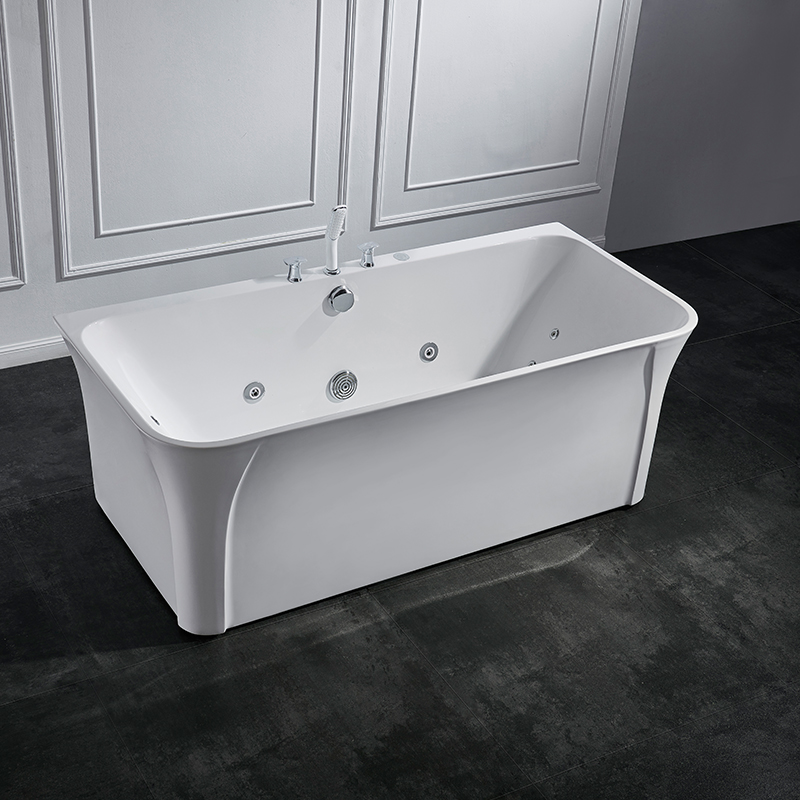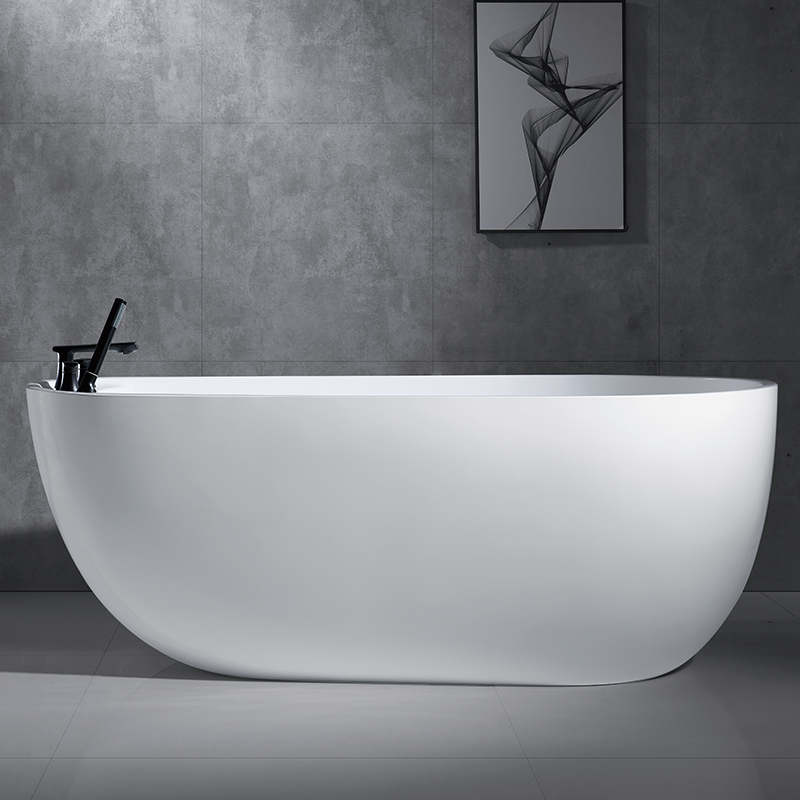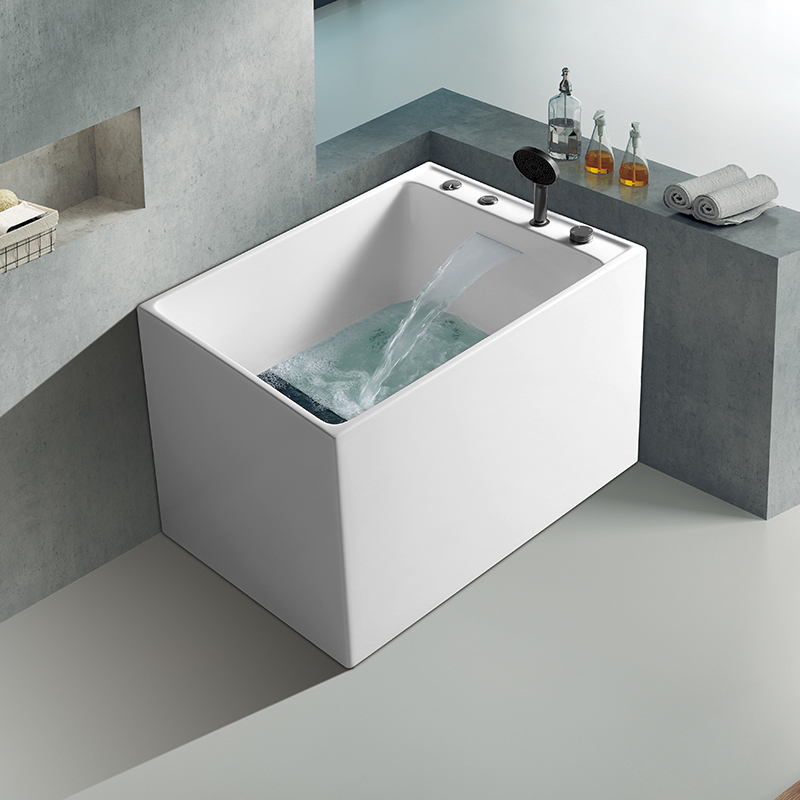Analysis of the Differences between American Standard Bathtubs and Chinese Standard bathtubs
As a core component of bathroom space, the design, size and function of bathtubs vary in different countries and regions due to living habits, architectural codes and aesthetic preferences. The United States and China each have their own characteristics in terms of bathtub standards, mainly reflected in the following aspects.

Differences in size and space design
1. American standard bathtub
● Large in size, emphasizing comfort and functionality: American residential bathrooms are generally spacious, so the standard bathtub size is usually quite spacious. The common dimensions are approximately 152-183 cm (60-72 inches) in length, 76-91 cm (30-36 inches) in width, and 46-61 cm (18-24 inches) in height. Some luxury bathtubs can be over 213 centimeters (84 inches) in length, emphasizing an immersive experience.
Freestanding design: Most bathtubs in the United States are designed as freestanding (Freestanding), commonly seen in open bathroom layouts, highlighting decorative and visual focus. Materials such as acrylic and cast iron are the main choices.
Massage and built-in coexistence: Whirlpool/Jetted Tub is quite popular in the United States. It is equipped with bubble and water flow massage functions and is usually large in size, suitable for family leisure needs. Meanwhile, Alcove tubs are also commonly found in compact bathrooms.
Chinese standard bathtub.
● Compact size, suitable for small Spaces: Due to the limited area of most family bathrooms, Chinese bathtubs are relatively compact in size. A common square bathtub is approximately 150 to 180 centimeters in length, 70 to 90 centimeters in width, and 58 to 75 centimeters in height. The small fan-shaped bathtub has a diameter of approximately 1.4 to 1.7 meters and is suitable for corner installation, saving space.
● Mainly embedded and semi-embedded: Chinese families mostly choose embedded or semi-sunken installation, which is convenient for integrated design with bathroom tiles, shower rooms, etc., and improves space utilization.
The functionality focuses on practicality: Although there are also massage bathtubs, ordinary household bathtubs mainly offer simple bathing functions, emphasizing cost-effectiveness and space adaptability.
Material and craftsmanship preferences
1. United States:
● Acrylic dominates: Acrylic is lightweight, has good heat insulation and comes in various shapes, making it the mainstream choice in the US market, accounting for approximately 70%. The high-end market prefers cast iron enamel bathtubs, which are durable and have a prominent texture.
● Pay attention to details and humanized design: such as anti-slip bottom, multi-angle backrest, built-in armrests, etc., to enhance the safety of use.
Pay attention to details and humanized design: such as anti-slip bottom, multi-angle backrest, built-in armrests, etc., to enhance the safety of use.
China
● Diversified materials: Acrylic, steel plates, cast iron, and wood (such as cedar wood bath buckets) are all applied. The mid-to-low-end market is mainly dominated by steel plate bathtubs and acrylic ones, which offer relatively high cost performance.
● Balancing environmental friendliness and durability: Wooden bathtubs are popular in some households, emphasizing natural and environmental friendliness, but they need regular maintenance to prevent cracking.
Differences between installation and specifications
1. United States:
● Drainage and piping standards: In accordance with American national standards (such as ASME A112.19.7), the drainage pipe diameter is usually 2 inches (approximately 5.1 cm), with emphasis on waterproof sealing and silent design.
● Water and electricity reservation standards: The water supply point of the bathtub should be approximately 30-40 centimeters above the ground. The reserved space must comply with the ADA (Americans with Disabilities Act) accessibility standards, such as low threshold design or auxiliary handrails.
China
● Compatible with domestic building standards: The drainage pipe diameter is mostly DN40/50, which must comply with national standards such as GB/T 6952. For embedded installation, attention should be paid to the treatment of the waterproof layer.
● Barrier-free design is gradually becoming more widespread: Age-friendly bathtubs (such as low-edge design and anti-slip treatment) have gradually gained attention in recent years, but the overall popularity rate is lower than that in the United States.
Cultural and usage habits influence
In the United States, bathtubs are often used as relaxation and family social Spaces. Some families are equipped with entertainment facilities such as televisions and audio systems, emphasizing a leisure experience.
2. China: More emphasis is placed on practicality and hygiene. Bathtubs are often combined with the shower function. Some families use bathtubs as a "backup" function, and their usage frequency is relatively low.
Summary and Suggestions
● Space adaptation takes priority: Large-sized bathtubs in the United States are suitable for spacious bathrooms, while compact designs in China are more appropriate for small-sized apartments.
● Balance between functionality and budget: The United States focuses on additional features (such as massage), while China pays more attention to basic bathing needs and cost-effectiveness.
● Installation should be adapted to local conditions: Follow local building codes to ensure compliance with details such as drainage and waterproofing.




